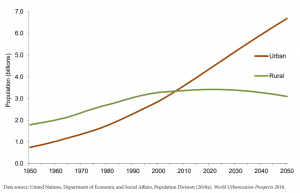
Table of Contents
What is Urbanization?
- Urbanization is the progression of society’s conversion from a largely rural to a primarily urban population.
- It simply means, increase in number of people living in the urban areas.
- ‘Urbanization is a complex socio-economic process that transforms the built environment, converting formerly rural into urban settlements, while also shifting the spatial distribution of a population from rural to urban areas’ (World’s Urbanization Prospects, 2018).
- Urbanization includes changes in occupation, lifestyle, culture and behavior of the people.
- Urbanization is closely linked to modernization and industrialization.
- Urbanization mainly refers to:
- growth in the number of people residing in urban settlements, and
- associated growth in the number of urban dwellers, in the size of cities and total area occupied by urban settlements
- According to the projections made by United Nations, the rural population has stopped growing while the urban population is growing at a rapid rate. There will be additional 1.5 billion urban residents in next 15 years and 3 billion by 2050 (UNFPA, 2016).
Key Facts About Urbanization:
According to World Urbanization Prospects, 2018:
- Globally, 55% of the world’s population are living in urban areas compared to 45% in the rural areas.
- In 1950, only 30% of the world’s population were urban. However, it is projected that 68% of the world’s population will be urban by 2050.
- The global urban population has rose from 751 million in 1950 to 4.2 billion in 2018.
- The global rural population is close to 3.4 billion in 2018 and will decline to 3.1 billion by 2050.
- Only India, China and Nigeria are together expected to be responsible for 35% growth in world’s urban population by 2050.
Urban and Rural Population of The World 1950-2050:

Globally, Which Region is Most Urbanized?
Here are the list of most urbanized regions in the world, ranking North America as the most urbanized and Africa as the least urbanized region till date (2018).
- North America: 82% people living in urban areas
- Latin America and the Carribean: 81% people living in urban areas
- Oceania: 68% people living in urban areas
- Asia: 50% people living in urban areas
- Africa: 43% people living in urban areas
Factors Contributing to Increasing Urbanization:
a) Push factors like;
- Lack of job opportunities
- Poor living conditions and poverty
- Poor health care
- Limited educational and economic opportunities
- Social and environmental vulnerability
- Political unrest and instability
- Natural calamities and disasters
- Man-made calamities like wars etc.
b) Pull factors like;
- Attractive economic benefits
- Better social mobilization
- Better empowerment opportunities in urban areas
- Better access to education and health services, including sexual and reproductive health care
- Peace, safety and security
- Better access to ETC. i.e. Education, Transportation & Communication
- Social factors, attractive living environment and lifestyles
c) Other factors:
- Natural population growth
Effects of Urbanization on Human Health:
- Spread of several infectious diseases.
- Unemployment
- Severe shortage of housing, clean water and sanitation
- Social effects: poverty, alcoholism, drugs, crime, violence, psychological problems
- Amplified mortality and morbidity
- Poor health care provision and facilities
Measures to Prevent Uncontrolled Urbanization:
- Constructing sustainable and environmentally friendly cities
- Establishment of essential services rural areas as well
- Creation of additional employments
- Population control
- Improve urban living conditions
- Advance urban making arrangements for sound practices and well-being
- Combat poverty by encouraging economic improvement and job establishment
- Decrease air pollution by promoting energy use and alternative transport schemes
- Form private-public partnerships to deliver facilities like waste dumping and accommodation
- Plant trees and integrate the maintenance of city green spaces as a crucial component in urban development.
Advantages of Urbanization:
- Development in industrial manufactures which aids the economic progress of the nation.
- Innovation, development and progress in business, science, industry and technology.
- Export growth and these forest reserve escalations.
- Cheaper goods and services
- Opportunities for sustainable growth and development
- Progress in tourism trades: People from foreign nations are appealed to good capitals and settlements having improved transport services.
- Upgrading science, culture, etc.
Limitations of Urbanization:
- Unmanaged urbanization rises intensification to housing difficulty causing increase in sub-standard housing and slum areas.
- Decreased agricultural production due to limited human resources for vast area of rural agricultural land
- Extreme poverty and exclusion
- Vulnerability and marginalization
- Rise and threat to different sorts of environmental pollution like water pollution, air pollution, soil pollution, land pollution etc.
- Increased environmental contamination and health threats
- Increase in criminal activities and crime rates due to unemployment and food insecurity
References and For More Information:
https://www.unfpa.org/urbanization
https://www.un.org/en/development/desa/population/theme/urbanization/index.asp
https://population.un.org/wup/Publications/Files/WUP2018-KeyFacts.pdf
https://population.un.org/wup/Publications/Files/WUP2018-Report.pdf
https://population.un.org/wup/Publications/Files/WUP2018-Highlights.pdf
https://www.who.int/world-health-day/2010/media/whd2010background.pdf
https://www.prb.org/urbanization-an-environmental-force-to-be-reckoned-with/
https://www.nationalgeographic.com/environment/habitats/urban-threats/
https://www.conserve-energy-future.com/causes-effects-solutions-urbanization.php
https://www.sciencedaily.com/terms/urbanization.htm
https://brainly.in/question/176381
https://www.lorecentral.org/2018/01/advantages-and-disadvantages-of-urbanisation.html
https://www.open.edu/openlearncreate/mod/oucontent/view.php?id=79940&printable=1
https://www.theclassroom.com/what-are-the-causes-of-urbanization-in-poor-countries-13660201.html
https://www.sciencedaily.com/terms/urbanization.htm